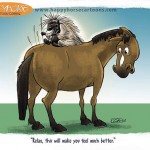
We all know about stress in people, but what about our horses? Horses were meant to be herd animals, wandering around the land, and grazing over 20 hours a day.
They are a “flight or fight” animal meaning fear or threat causes physiological changes (adrenaline, cortisone, increased heart rate, and increased blood to muscles) causing them to run away or fight by biting, kicking, rearing, and striking. Yet we “break” them to behave how we want which conflicts with their natural instinct.
We confine them to stalls and paddocks, oftentimes with horses as stablemates they may not choose if given the choice. Many show and race horses only get to exercise an hour a day and even then we control them during that time.
We feed meals of hay and high concentrated grains giving them lots of energy while only keeping them busy a few hours a day. We expect them to walk onto trailers, which are moving, confining, noisy, and unnatural objects to be feared. All these factors contribute to their stress.
Continue reading Tip of the Week – Helping Our Horses with Stress!








